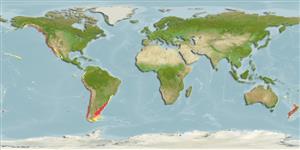Holocéfalos (quimeras) (chimaeras) >
Chimaeriformes (Chimaeras) >
Callorhinchidae (Plownose chimaeras)
Etymology: Callorhinchus: Tautonymous with Chimaera callorynchus Linnaeus 1758 (but unnecessarily emended from -rynchus to -rhinchus: callum (L.), hard skin; rhynchus (L.), snout, referring to peculiar hoe-shaped proboscis. (See ETYFish); callorynchus: callum (L.), hard skin; rhynchus (L.), snout, referring to peculiar hoe-shaped proboscis. (See ETYFish).
More on author: Linnaeus.
Environment: milieu / climate zone / depth range / distribution range
Ecología
marino demersal; rango de profundidad 10 - 116 m (Ref. 34015). Subtropical; 5°C - 10°C (Ref. 34015); 3°S - 56°S, 82°W - 43°W
Southeast Pacific and Southwest Atlantic.
Tamaño / Peso / Age
Maturity: Lm ? range ? - ? cm
Max length : 89.2 cm SL macho / no sexado; (Ref. ); common length : 70.0 cm TL macho / no sexado; (Ref. 6077)
Short description
Morfología | Morfometría
Espinas dorsales (total): 1. Pectorals very large (Ref. 27363).
Occurs in sandy and muddy substrates. Apparently associated with Stromateus brasiliensis and Discopyge tschudii (Ref. 34015). Oviparous (Ref. 50449). Max length (Itamar Alves Martins, pers. comm., 2002).
Life cycle and mating behavior
Madurez | Reproducción | Puesta | Huevos | Fecundidad | Larva
Menni, R.C., R.A. Ringuelet and R.H. Aramburu, 1984. Peces marinos de la Argentina y Uruguay. Editorial Hemisferio Sur S.A. Buenos, Aires, Argentina. 359 p. (Ref. 2806)
IUCN Red List Status (Ref. 130435)
Threat to humans
Harmless
Human uses
Pesquerías: comercial
Más información
ColaboradoresImágenesStamps, Coins Misc.SonidosCiguateraVelocidadTipo de nataciónSuperficie branquialOtolitosCerebrosVisión
Herramientas
Special reports
Download XML
Fuentes de Internet
Estimates based on models
Preferred temperature (Ref.
123201): 7.5 - 14.8, mean 11.3 °C (based on 125 cells).
Phylogenetic diversity index (Ref.
82804): PD
50 = 0.7500 [Uniqueness, from 0.5 = low to 2.0 = high].
Bayesian length-weight: a=0.00457 (0.00218 - 0.00958), b=3.13 (2.93 - 3.33), in cm total length, based on LWR estimates for this species & (Sub)family-body (Ref.
93245).
Nivel trófico (Ref.
69278): 3.4 ±0.1 se; based on diet studies.
Resiliencia (Ref.
120179): Bajo, población duplicada en un tiempo mínimo de 4.5-14 años (Fec assumed to be <100).
Fishing Vulnerability (Ref.
59153): High to very high vulnerability (65 of 100).
Nutrients (Ref.
124155): Calcium = 36.4 [9.4, 104.6] mg/100g; Iron = 0.898 [0.331, 3.776] mg/100g; Protein = 14 [11, 18] %; Omega3 = 0.238 [0.103, 0.526] g/100g; Selenium = 28.6 [5.8, 75.6] μg/100g; VitaminA = 7.6 [2.6, 20.9] μg/100g; Zinc = 0.617 [0.320, 1.178] mg/100g (wet weight); based on
nutrient studies.
